Creating a cozy and comfortable bedroom isn’t just about aesthetics; it’s about crafting a personal sanctuary that promotes relaxation and restful sleep every night. Good sleep is fundamental to our health, affecting everything from mental sharpness and emotional balance to physical vitality and disease resistance. Therefore, designing a bedroom that encourages quality sleep is crucial. Whether you’re looking to revamp your current space or start from scratch, there are several key elements that can transform your bedroom into a cozy haven. This guide will walk you through the essential steps to design a bedroom that not only looks inviting but also enhances your overall well-being and sleep quality. By focusing on elements like the right mattress, soothing colors, and appropriate lighting, you can create an environment that significantly improves your sleep, ensuring you wake up refreshed and ready to face the day.
Choosing the Right Bedding
The foundation of any cozy bedroom is the bedding. Opt for high-quality, soft materials that invite you to curl up and relax. Natural fibers like cotton, linen, or bamboo are breathable and gentle on the skin, providing comfort throughout the year. During colder months, adding layers such as plush comforters or fluffy duvets can provide extra warmth and texture. Remember, the right bedding not only comforts but also sets the tone for your room’s decor.
Selecting the Perfect Mattress
A good night’s sleep starts with a great mattress. Investing in a high-quality mattress like a Sealy mattress can make a significant difference in your sleep quality and, by extension, your daily energy levels. Sealy mattresses are known for their support and comfort, adapting to your body’s needs and ensuring a restful night. When choosing a mattress, consider factors like firmness, size, and material to ensure it meets your specific sleep preferences.
The Role of Color in Comfort
Color psychology plays a pivotal role in setting the mood of your bedroom. Soft, soothing colors like pastel blues, greens, and warm neutrals can create a calming atmosphere conducive to relaxation and sleep. On the other hand, vibrant colors can energize the space if used as accents rather than primary colors. Choose your palette carefully to reflect the kind of environment you want to foster in your bedroom.
Lighting: Setting the Mood
Proper lighting is crucial in a bedroom, not just for aesthetics but for functionality. Soft, warm lights can create a relaxing ambiance, perfect for unwinding before bed. Consider using dimmable lamps or installing smart lights that you can adjust to mimic the natural progression of the sun, supporting your natural sleep-wake cycle. Strategic placement of lighting can also highlight the room’s best features while ensuring there are no harsh glares.
Incorporating Comforting Textures
Textures can dramatically alter the feel of a bedroom, adding layers of comfort and warmth. Think plush rugs, soft throw pillows, and rich, woven blankets that invite touch. These elements not only enhance the room’s aesthetic but also contribute to a deeper sense of comfort. Mixing textures can provide both visual and tactile diversity, keeping the room interesting and inviting.
Effective Use of Space
Maximizing the use of space is essential in creating a comfortable bedroom, especially if the area is limited. Functional furniture that doubles as storage, such as ottomans, under-bed drawers, and multi-functional nightstands, can help keep clutter at bay while maintaining a clean and tranquil environment. Well-planned layouts emphasize ease of movement and accessibility, ensuring that everything you need is within easy reach yet out of the way to maintain a sense of order and spaciousness.
Personalizing Your Bedroom
Personal touches in your bedroom can transform it from a standard space to your personal retreat. Incorporate elements that reflect your personality, such as artwork, family photos, or a collection of your favorite books. These personal items can enhance the comfort level by making the space uniquely yours, contributing to a sense of belonging and peace. However, balance is key; too many items can make the space feel cluttered rather than cozy.
The Importance of Soundproofing
Minimizing noise can significantly increase the comfort level of your bedroom. Consider soundproofing techniques like thick curtains, double-paned windows, or even adding a bookshelf against a noisy wall. Soft materials such as rugs on the floor can also help absorb sound, creating a quieter, more serene environment that is conducive to relaxation and sleep.
Creating a Scented Sanctuary
Scents can have a profound impact on mood and relaxation. Introducing calming aromas such as lavender, chamomile, or vanilla through candles, diffusers, or room sprays can help create a more relaxing atmosphere in your bedroom. These soothing scents can decrease stress and enhance sleep quality, making them a simple yet effective way to boost the overall ambiance of the room.
Regular Updates for Freshness
Keeping your bedroom fresh and inviting can involve regular updates to the decor. This doesn’t mean complete overhauls; small changes like new bedding, a different area rug, or seasonal decorations can reinvigorate the space. These updates can keep the room feeling fresh and loved, which is important for a place where you spend a significant part of your day.
Conclusion
Creating a cozy and comfortable bedroom is about more than just aesthetics; it’s about crafting a space that nurtures relaxation and rejuvenation. By carefully selecting the right mattress, such as a Sealy mattress, and combining it with strategic choices in bedding, lighting, and color, you can create a sanctuary that promotes excellent sleep and provides a personal haven from the world. Personal touches and attention to sensory experiences like touch and smell further enhance this space, making your bedroom not just a place to sleep, but a cherished part of your home where comfort and relaxation are paramount. Remember, the most comfortable bedrooms are those tailored to meet the unique needs and preferences of those who dwell in them.





